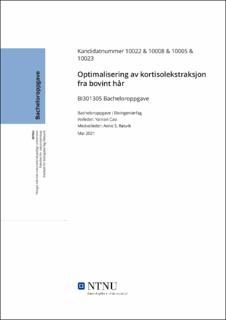| dc.contributor.advisor | Cao, Yanran | |
| dc.contributor.advisor | Røsvik, Anne Synnøve | |
| dc.contributor.author | Almli, Ida-Cathrin | |
| dc.contributor.author | Gran, Henrik | |
| dc.contributor.author | Dale, Erlend Swe | |
| dc.contributor.author | Moldesæter, Jonas | |
| dc.date.accessioned | 2021-09-25T16:47:15Z | |
| dc.date.available | 2021-09-25T16:47:15Z | |
| dc.date.issued | 2021 | |
| dc.identifier | no.ntnu:inspera:83595591:83601306 | |
| dc.identifier.uri | https://hdl.handle.net/11250/2783522 | |
| dc.description.abstract | I dette forsøket var målet å optimalisere metode for måling av kortisol fra hårprøver. I forsøket ble det brukt hår fra kyr. Det er gunstig å finne en god optimalisert og standardisert metode for prepareringen, slik at resultatene i større grad blir sammenlignbare.
Det ble utført seks forskjellige ekstraksjonsmetoder for kortisol på seks forskjellige hårprøver for å svare på problemstillingen; «Hvilken ekstraksjonsmetode gir høyest mengde ekstrahert kortisol?». Resultatet ble vurdert ut fra hvilken metode som ga høyest konsentrasjon av kortisol ved analysering, da det å få ekstrahert så mye kortisol som mulig vil gi det mest korrekte resultatet. Preparering og ekstraksjon av prøvene ble gjort i batch etter metode. Konsentrasjonene ble kvantitert ved hjelp av kompetitiv ELISA-analyse fra NEOGEN.
Det ble benyttet hår fremfor andre medium, som eksempelvis blod, feces eller spytt grunnet at kortisol målt i blod, feces og spytt ikke vil kunne si noe om kortisol over lengre tid - kortisolnivåene målt vil kun være representativt for tidspunktet prøven ble tatt. Kortisolnivåene vil da også muligens være påvirket av forhøyede stressnivåer, som for eksempel en blodprøvetaking kan forårsake.
Resultatene fra forsøket viser at temperatur ikke har en betydelig innvirkning på resultatene. Det som hadde høyest innvirkning på kortisol konsentrasjon var om prøven var knust eller ikke. I tillegg var det en betydelig forskjell på prøver som ble knust ved hjelp av Tissuelyser II og prøver som ble knust ved hjelp av både Tissuelyser II og sonikering. Prøver knust med sonikering og Tissuelyser II hadde de høyest konsentrasjonsnivåene. | |
| dc.description.abstract | Abstract
'The goal of this study was to optimize the process of cortisol extraction from hair samples. In this study, hair from cows was used. It would be beneficial to find the most optimized method for preparation of samples for cortisol extraction, as so the results between different laboratories will be comparable. Six different methods of cortisol extraction were performed on six different samples of hair to answer the question; ''Which extraction method gives the highest amount of extracted cortisol?''. The results were assessed on the basis of which method gave the highest concentration of cortisol, as extracting the highest amount of cortisol will give the most correct result. Preparation and extraction of the samples were done in batch by method. The results were quantified by using a competitive ELISA kit made by NEOGEN CORPORATION.
Hair was used over other media, such as blood, faeces or saliva due to the fact that cortisol measured in blood, faeces and saliva will not be able to say anything about long-term cortisol levels, as the cortisol levels measured will only be representative of the time the sample was taken. Cortisol levels measured by such methods might also possibly be affected by elevated stress levels, which for instance taking a blood sample can cause.
The results from the experiment show that temperature does not have a significant effect on the results. What had the highest effect on cortisol concentration was whether the sample was crushed or not. In addition, there was a significant difference between samples that were crushed using Tissuelyser II and samples that were crushed using both Tissuelyser II and sonication. Samples crushed by sonication and Tissuelyser II had the highest concentration levels.' | |
| dc.language | nob | |
| dc.publisher | NTNU | |
| dc.title | Optimalisering av Kortisolekstraksjon fra Bovint Hår | |
| dc.type | Bachelor thesis | |
